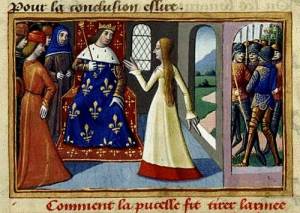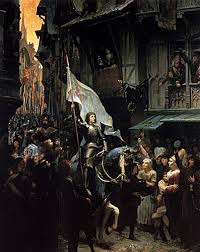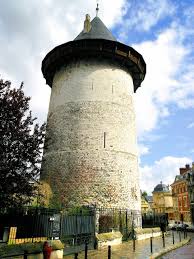By Student Carolie Wolf
“I would rather die than do what I know to be sin”
“I protest against being kept in chains and irons”
Here are many fine websites about Joan. This one here is more personal and created by a student, Carolie Wolf. Carolie sees Joan as a medieval version of Katniss Everdeen, from The Hunger Games trilogy. Perhaps Joan was a model for this 21st century warrior and young woman defending the people she loves. Carolie also shows how Joan is connected to the film Frozen.

Saint Joan of Arc:
- Born: 1412 in Domrémy-la-Pucelle, France
- Birth name: Jeanne d’Arc
- Died: May 30, 1431, Rouen, France
- Patron Saint of: France ; martyrs; captives; military personnel; people ridiculed for their piety; prisoners; soldiers.
- Beatified: April 19, 1909
- Canonized: May 16, 1920
Joan of Arc is the Katniss Everdeen of her time. She is definitely is one bad chick. She accomplished so much in her short time alive, and meant a lot to men and women alike, even though she was burned to death at age 19.
Joan of Arc was born to a family of peasants, and not much after that is recorded, but the important part is she had visions of angels and heard voices that would tell her to save her country, and all of her family and town told her not to pursue these visions for the longest time, and then eventually, when she decided not to give up her faith, they finally supported her and some rich people who lived near her gave her money to go to Chinon, France to see the king, King Charles the seventh.

Charles believed her that she was hearing the voices from angels and, since it was the middle of a war (the Hundred Years War), he decided that he would let her lead 5,000 men into battle, which would be called the Seige of Orléans, where Joan led her men to victory over the English, which gave her the lasting name of The Maid of Orléans.

After that she led her men through a few more successful battles, driving the English to the far north of France, and then eventually got shot with an arrow and captured by the Duke of Burgundy, Philip the Bold, at Compiègne and then sold to the English.
After her capture by the English, Joan was tried for witchcraft, heresy, and dressing as a man. She was locked in a tower at Rouen and she still stood by her beliefs, and never gave up her faith even though it could save her life, she still stood by her visions from angels.

The charges for witchcraft didn’t stick, after Joan was interrogated by English priests, but being that she still was a leader of the French army, they kept the charge of cross dressing and heresy (for saying that she had direct communication from God) and was burned at the stake on May 30, 1431, at the age of 19.
Pope Benedict XV canonized Joan on 16 May 1920.
The people who came after her in the five centuries since her death tried to make everything of her: demonic fanatic, spiritual mystic, naive and tragically ill-used tool of the powerful, creator and icon of modern popular nationalism, adored heroine, saint. She insisted, even when threatened with torture and faced with death by fire, that she was guided by voices from God. Voices or no voices, her achievements leave anyone who knows her story shaking his head in amazed wonder.
—Stephen Richey
Links for pictures:
- http://www.maidofheaven.com/joanofarc_pictures5b.asp
- http://www.maidofheaven.com/maid_assets/extras/joancharlesviimeet.jpg
- http://www.maidofheaven.com/joanofarc_orleans.asp
- http://www.frenchmoments.eu/wp-content/uploads/2012/11/Tour-Jeanne-dArc-photo-de-B.-Voisin.jpg

Canonization
Canonization is just the process that the Catholic church has to go through to make a holy person a saint. A saint (click there to see the saint of the day, or explore on the site to read more about saints. There’s even a patron saint of television!) is just a person recognized by the Catholic church that possess holy qualities that Catholics can look towards for guidance, or pray to for specific reasons, like if they loose something (St. Anthony of Padua), or even something random like bee keepers (St. Ambrose).
There are four steps to canonization, and this is just going to be a very brief summary, but click on the link here for the Wikipedia page.
-The Steps to Canonization
It begins at the local level where the eventual saint was either buried/burned/died and usually a bishop (the leader of all the churches in an area) will propose the idea of a certain person becoming a saint. The pope (leader of the catholic church for the whole world) can also recommend someone to start the process of becoming a saint.
- “Servant of God”: in the process, writing about the person and by the person (if it applies) are found and a biography is written about them. They then get permission to (if it applies) to dig up the body. The reason this happens is actually really cool, it’s to get artifacts that they could have been buried with, but also in the case of some of the saints, their body’s did not decompose which shows their holiness. (click here to see saints who didn’t decompose, or have “incorrupt bodies”)

Saint Bernadette’s body on display in Nevers, France. It has not decayed, but a layer of wax was placed over her face to cover some skin patches for presentablility. - “Venerable/Heroic in Virtue”: Next, once the person in question becomes a “servant of God,” they then have to prove that they possess the virtues of a saint. It’s then the Popes job to look through the things they found and see if they show all of the values of faith, hope, charity, prudence, justice, fortitude, and temperance. If they show all of these, they earn the title of “venerable.”
- “Blessed/beautification”: for the “venerable” to become “blessed” they must either be a martyr or a “confessor.” If they’re a martyr, meaning they died for what they believed in, they’re good to go on to try and be a saint. If they aren’t, they must have confessed to their faith, and that means God showed them a sign, maybe in the form of a miracle, which most of the times are miraculous cures to diseases.
- “Saint”: after these have all been confirmed and lastly they must must prove that there were at least two miracles after the saint has died, or just one more if to be “blessed” there was a miracle, which can also be a miraculous cure when this saint is being prayed to. And for a miraculous cure, it must be non-treatable or terminal (deadly) and the illness doesn’t ever come back.
Links for pictures:
- http://www.catholiccourier.com/news/world-nation/rome-prepares-for-influx-ahead-of-canonizations/
- http://commons.wikimedia.org/wiki/File:Bernadette_Soubirous-sarcophagus-2.jpg
Joan of Arc is still a huge influence on people that she gets mentioned often in media, whether making fun of the fact that she got burned at the stake, or the fact that she is a strong women that overcame what was expected of her as a woman and led her country to win many battles.
Family Guy
- A video making fun of Joan for dressing like a man and acting like a man
Frozen
- Start at 1:05, unless you just love Frozen like me and want to watch it anyway 🙂
And the interpretation of this short scene by Cosmokyrin on Tumblr:
I’d often remember Joan of Arc’s story whenever I see her. And we all know that movies always have little bits of details which usually refers to something in the film.
Joan was accused of witchcraft (which later turned into heresy) and was burned to death. Showing the painting could have been referring to Elsa being accused of malice. So in the “Do You Want to Build a Snowman” segment of the show, the part where Anna jumps to the couch and says, “Hang in there Joan,” could be alluding to Anna telling Elsa to hang on ‘cause she’s going to save her from condemnation.”
Epic Rap Battles of History
*WARNING: CONTENT IS EXPLICIT*
Horrible Histories
This is actually funny, British humor for the win.
Arcade Fire: Joan of Arc with Lyrics
If you want to check more of these out, click here, there’s a whole list on Wikipedia of every time Joan of Arc is written about, sung about, sculpted, painted, and mentioned in television shows!
Works Cited
Richey, Stephen W. Joan of Arc: The Warrior Saint. Westport, CT: Praeger, 2003.
Works Consulted
http://en.wikipedia.org/wiki/Canonization
lordsandladies.org/joan-of-arc.htm
http://www.biography.com/people/joan-of-arc-9354756#historical-background&awesm=~oCHi9PK52JmGNg
http://www.history.com/news/7-things-you-didnt-know-about-joan-of-arc
http://en.wikipedia.org/wiki/Joan_of_Arc
http://archive.joan-of-arc.org/joanofarc_short_biography.html
http://www.newadvent.org/cathen/08409c.htm
You must be logged in to post a comment.